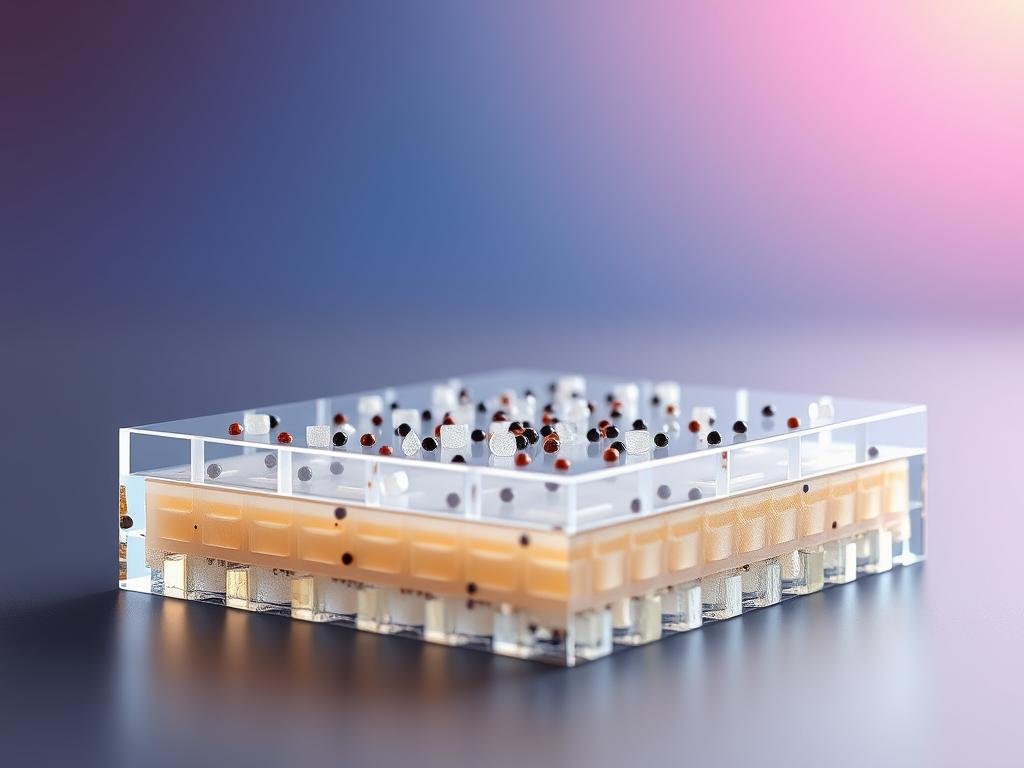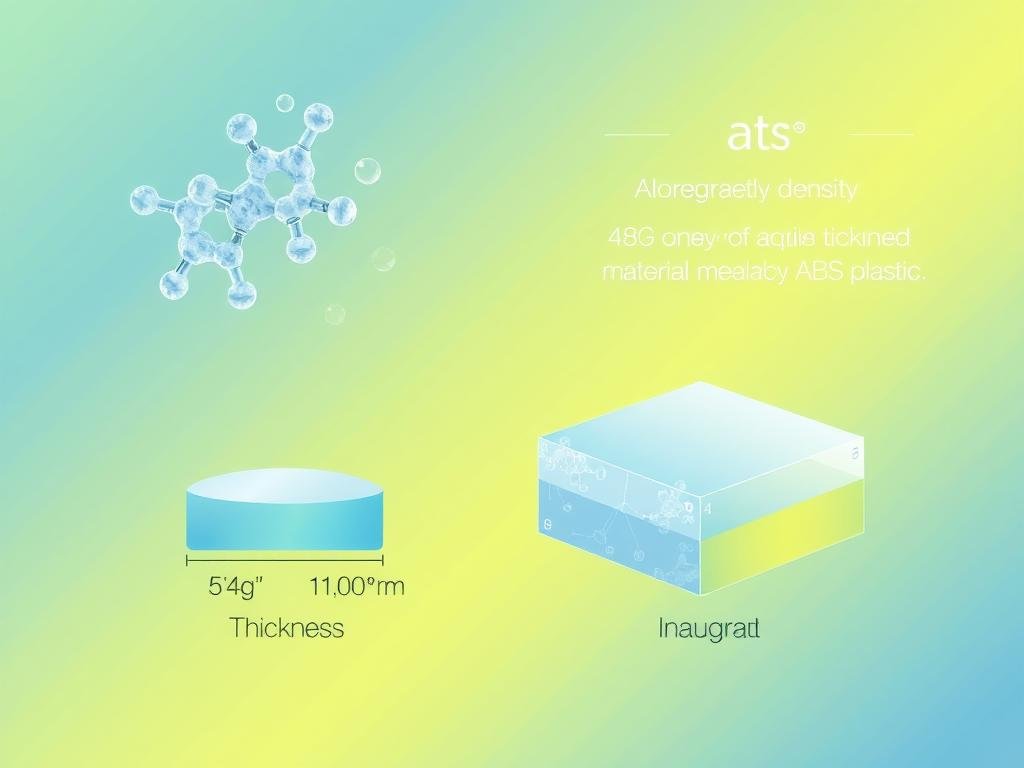Understanding the properties of materials is crucial for engineers, designers, and makers. One key property is the densité of Acrylonitrile Butadiene Styrene (ABS), a widely used material in various applications.
The density of ABS affects its performance in different uses, from automotive parts to 3D printing projects. Knowing the density value, which ranges from 0.9-1.53 g/cm³, is vital for calculating material needs, structural integrity, and cost efficiency.
This guide explores how ABS density influences its mechanical properties, including strength, impact resistance, and heat deflection capabilities, providing insights into manufacturing processes like injection molding and 3D printing.
Understanding ABS Plastic Composition and Properties
Understanding the composition and properties of ABS plastic is crucial for engineers to select the right material for their applications. ABS (acrylonitrile butadiene styrene) is a terpolymer composed of three distinct monomers: acrylonitrile, butadiene, and styrene.
Chemical Composition of ABS
The chemical composition of ABS typically consists of 15-35% acrylonitrile, 5-30% butadiene, and 40-60% styrene. This unique blend creates a versatile thermoplastic with balanced mechanical properties. The proportions of these monomers can be adjusted to achieve specific performance characteristics.
| Monomer | Proportion | Contribution |
|---|---|---|
| Acrylonitrile | 15-35% | Chemical resistance, rigidity, and heat stability |
| Butadiene | 5-30% | Impact strength and toughness |
| Styrene | 40-60% | Glossy finish and improved processing characteristics |
Key Mechanical Properties of ABS
ABS offers a favorable balance of mechanical properties, including tensile strength, impact resistance, and heat deflection temperature. The material’s tensile strength is typically around 6,100 psi, with a heat deflection temperature of approximately 215°F.
How ABS Properties Affect Engineering Applications
The properties of ABS make it suitable for a wide range of engineering applications. By adjusting the proportions of its constituent monomers, manufacturers can create specialized grades with enhanced performance metrics for specific applications. Understanding the relationship between ABS composition and its resulting properties is essential for engineers when selecting the appropriate material grade for parts that require specific performance characteristics.

ABS Plastic Density: Detailed Analysis

When working with ABS plastic, it’s essential to consider its density to ensure optimal performance in various applications. The density of ABS plastic is a critical factor that affects its weight, material costs, and structural integrity in different engineering and consumer product applications.
Standard Density Range of ABS
The density of ABS plastic typically ranges from 0.9 to 1.53 g/cm³, with most standard grades having a median value of approximately 1.07 g/cm³. This makes ABS heavier than polyethylene but lighter than many engineering thermoplastics. Understanding this density range is crucial for engineers and designers to make informed decisions about material selection and component design.
Factors Affecting ABS Density
Several factors can affect ABS density, including the specific formulation (proportions of acrylonitrile, butadiene, and styrene), the presence of additives, fillers, or reinforcements, and the manufacturing process parameters. For instance, the addition of flame retardants can increase the density of ABS, while the incorporation of impact modifiers can decrease it. These variations in density can significantly impact the performance and cost-effectiveness of ABS in different applications.
Density Variations in Different ABS Grades
Specialized ABS grades exhibit different density values. Fire-retardant ABS has a higher density (1.15-1.20 g/cm³) due to added flame inhibitors, while high-impact ABS has a lower density range (1.00-1.10 g/cm³) because of increased butadiene content. ABS/PC blends, commonly used for enhanced heat resistance and impact strength, have densities in the range of 1.10-1.15 g/cm³. Understanding these density variations is particularly important in injection molding and 3D printing applications, where precise material calculations are needed for proper mold filling and part design.
Comparing ABS Density to Other Common Plastics
Understanding how ABS density compares to other common plastics is essential for making informed material choices. ABS plastic, with its median density of 1.07 g/cm³, serves as a benchmark for comparing the density of various thermoplastics used in engineering applications.
ABS vs. Polypropylene (PP) Density
Polypropylene (PP) has a significantly lower density, ranging from 0.90 to 0.91 g/cm³, compared to ABS. This lower density makes PP advantageous for applications where weight reduction is critical, such as in automotive components. For instance, PP’s lower density allows it to float on water, whereas ABS sinks due to its higher density. PP is also generally less expensive than ABS, durable, tough, and flexible, with low moisture absorption. However, ABS has its own set of advantages, including better impact resistance and a more consistent performance in various environmental conditions.
ABS vs. PLA and Other 3D Printing Materials
In 3D printing applications, PLA (Polylactic Acid) is a popular alternative to ABS, with a higher density ranging from 1.23 to 1.25 g/cm³. This means that PLA printed parts will be heavier than ABS parts of the same dimensions. Other 3D printing materials like HDPE (0.94-0.97 g/cm³) and PC (1.20 g/cm³) also have varying densities, affecting the weight and material consumption of printed parts. For example, HDPE is less dense than ABS, while PC is denser. The choice between these materials depends on the specific requirements of the application, including factors like tensile strength, heat resistance, and impact toughness.

Density Comparison Table for Engineering Reference
A comprehensive density comparison table is a valuable resource for engineers and designers. It allows for quick reference when selecting materials based on density and other critical properties. Here’s a brief overview of the density values for common plastics:
| Matériau | Densité (g/cm³) |
|---|---|
| ABS | 1.07 |
| PP | 0.90-0.91 |
| PLA | 1.23-1.25 |
| HDPE | 0.94-0.97 |
| PC | 1.20 |
This table illustrates the varying density values among common plastics, helping engineers make informed decisions based on weight requirements, structural needs, and manufacturing processes.
Engineering Applications Based on ABS Density Properties
ABS density significantly influences its performance in various engineering contexts, from automotive to consumer electronics. The material’s properties make it suitable for a wide range of applications where a balance of weight, strength, and impact resistance is required.
Applications automobiles et industrielles
In the automotive sector, ABS is valued for its density properties, which contribute to the production of lightweight yet durable components such as dashboard trim and exterior parts. The density-to-strength ratio of ABS makes it an ideal material for these applications. Industrial applications also benefit from ABS’s density, as it is used in manufacturing equipment housings and protective casings that require durability without excessive weight.
Consumer Products and Electronics
Consumer electronics manufacturers leverage ABS’s density properties to create device housings that are both durable and lightweight. The material’s balanced weight-to-strength metrics allows for the production of products that feel substantial without being unnecessarily heavy. Additionally, ABS is used in various household goods and appliances due to its favorable density characteristics.
3D Printing Considerations for ABS Density
When using ABS in 3D printing, understanding its density is crucial for calculating material requirements and estimating final part weight. The density of ABS affects its warping tendencies during the printing process, necessitating specific techniques such as heated build chambers and adhesion promoters to achieve dimensional stability.
| Application | Density Requirement | ABS Suitability |
|---|---|---|
| Automobile | Rapport résistance/poids élevé | Excellent |
| Électronique grand public | Balanced weight and durability | Bon |
| Impression 3D | Low warping, high dimensional stability | Fair, with proper techniques |
Conclusion: Making Informed Material Choices with ABS
The density of ABS plastic serves as a fundamental metric for evaluating its potential in a wide range of applications. Understanding this property, which ranges from 0.9 to 1.53 g/cm³ with a median of 1.07 g/cm³, is crucial for engineers and makers to make informed decisions.
When selecting materials, it’s essential to consider density alongside other critical propriétés such as impact resistance and tensile strength. The versatile nature of ABS allows for formulation adjustments, enabling the creation of specialized grades for specific uses.
Engineers should also consider how ABS density affects processus de fabrication, including injection molding and 3D printing. By leveraging the knowledge presented in this guide, professionals can optimize designs, improve manufacturing efficiency, and create better-performing end products.
